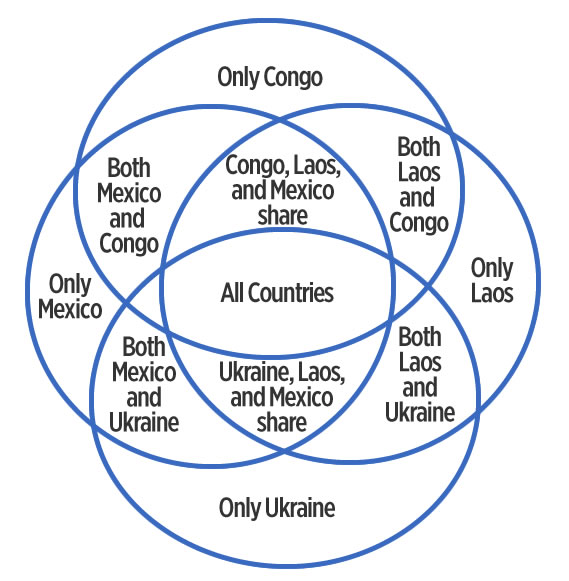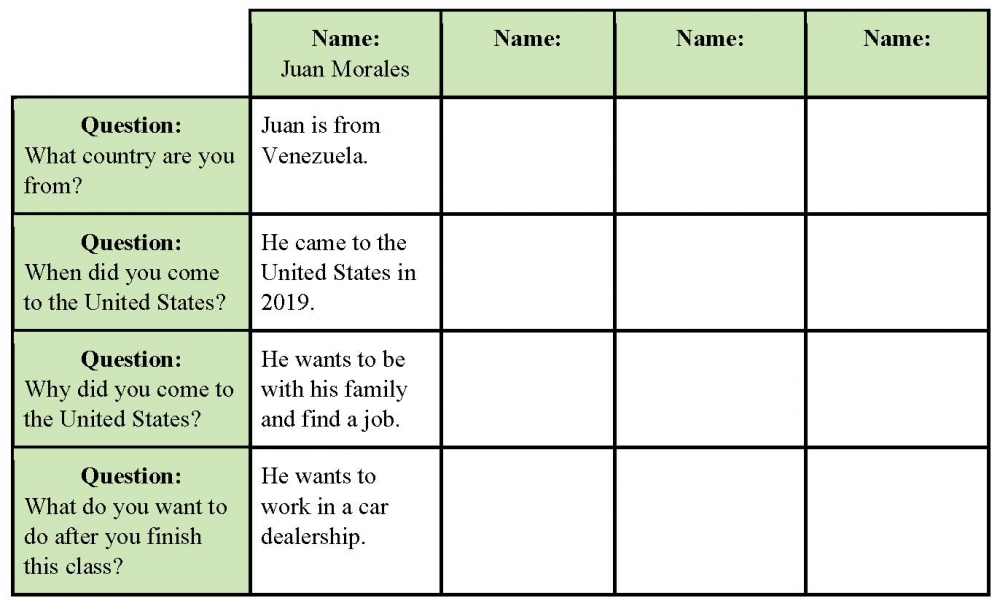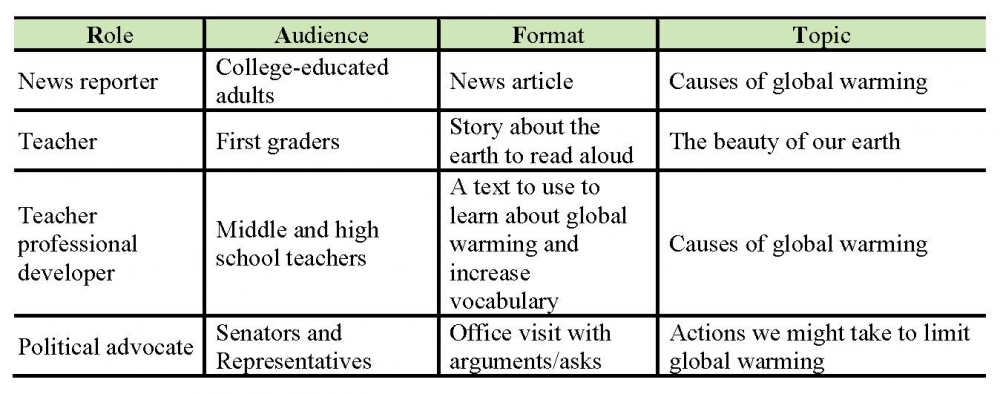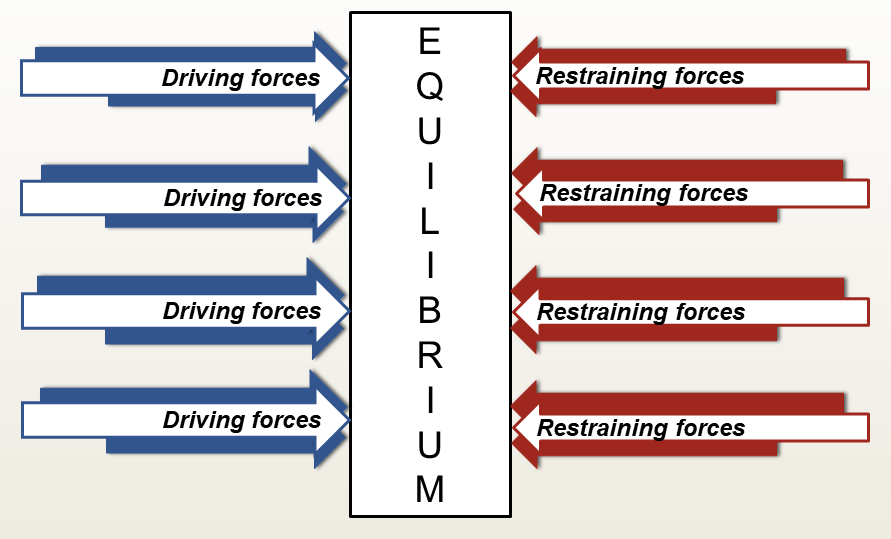Adult Learners in SLW (Part 2): Using Graphic Organizers
by Joy Kreeft Peyton

In the first
article in this series, Rebeca Fernandez provides guidance on
designing a course that provides adult English learners with multiple
opportunities to use writing toward personal, academic, and professional goals.
(See also discussion of these in Fernandez et al., 2017). The list of what
learners need to be able to do in writing is long; mastering these skills is
not easy; and students often feel anxious, alone, and unsupported as they seek
to fulfill writing assignments which the teacher, often a native speaker of
English, will read and judge (Martinez et al., 2011; Minahan & Schultz,
2015). In order to support them, teachers need to
-
develop and implement
activities that connect oral language, reading, and writing that is related to
the content that is the focus of instruction;
-
develop topics and
structure for the writing;
-
align these with the
writing standards followed in the program; and
-
ensure, through ongoing
observation and assessment, that learners are developing these skills and
abilities.
Providing many opportunities for learners to engage in academic and
professional writing and providing clear, specific, visible supports for
developing this type of writing is critical. Ferlazzo (2017) and Lee (2017)
argue that the ability to produce written products at this level is achievable
when students have appropriate supports of teacher guidance and scaffold-rich
curricula.
Providing Scaffolds for Writing
There are a
number of perspectives on ways to help learners be successful writers through
supported interaction, scaffolding in the zone of proximal development, and
apprenticeship. Vygotsky (1962, 1968) described the process of learning in the
space or “zone of proximal development,” in which the learner is working to
solve a problem or accomplish a task, and the teacher or a more competent peer
“scaffolds” the learning by working collaboratively with the learner and
demonstrating ways to move forward.
One type of
scaffold and support that can help adult learners develop proficiency with academic
writing is graphic organizers, which provide a framework for shaping key ideas
in a written piece. Also known as a knowledge map, concept map, story map,
cognitive organizer, advance organizer, or concept diagram, a graphic organizer
uses visual symbols to represent knowledge, concepts, thoughts, or ideas in a
text and show the relationships among them.
Using Graphic Organizers in
Instruction
Jiang and
Grabe (2007) conducted research on the use of graphic organizers in reading
instruction and concluded that they are an effective way to facilitate text
comprehension because they make the structure of texts visible. Here, we focus
on the use of graphic organizers to develop ideas for and approaches to writing
an academic text with learners at different levels.
Wrigley and Isserlis (n.d.) provide examples
of graphic organizers that can be used in adult English as a second
language (ESL) literacy classes at many different levels of ability, fluency,
and comfort with reading and writing. They argue that graphic organizers
provide opportunities for basic-level literacy learners (in any language) to
contribute content and information and to raise topics and questions of interest
as part of the process of developing oral and written language (e.g., getting
to know one another, listing languages that they speak, listing favorite
activities). LINCS
and KET
Education also have helpful resources for using graphic organizers
with adult learners.
Two commonly
used graphic organizers are a KWL chart and a Venn diagram, which are widely
used in K–12 and adult education. Here, I give an example of how each one could
be used in an adult education class, with the focus and vocabulary of a specific
lesson topic. In the next sections, I describe less commonly used graphic
organizers.
Table 1 shows a KWL chart developed by a class that
is studying, thinking about, and using vocabulary related to climate
change.
Table 1. Example KWL
Chart – Climate Change
|
Know |
Want to Know |
Learned |
|
Earth’s
temperatures are getting warmer. |
What are all of
the causes of climate change? |
Climate change is
caused by both natural changes to the earth and oceans and by human
activity. |
Another
topic that a class might focus on is key features of the countries of origin of
the students in the class. Students might work in pairs and complete a Venn
diagram, each focusing on their country. They would write the name of one
country at the top of one of the circles and the other country at the top of
the other circle. Working together, they would list features of their countries
that are different, in the outer part of the circles, and features that are the
same in the center section. This activity could lead to a considerable amount
of discussion, reading, and writing. If the entire class then came together to
consider the countries of origin of all of the students in the class, the Venn
diagram would have as many overlapping circles as the countries involved (see
Figure 1). The result could be writing informational pieces (about one’s own or
another person’s country), comparative writing (describing how the two countries
are similar or different), or argumentative writing (making a statement about
the key features of the two or more countries and defending it with data).

Figure 1. Example Venn diagram: countries students
are from.
Using Graphic Organizers With
Students at Different Levels
Graphic
organizers can be used with adult English learners at different levels, from
low beginning and beginning to advanced. (Some of these examples come from
interviews that Kirsten Schaetzel, Rebeca Fernandez, and I did with adult ESL
teachers about ways that they teach writing. The approaches are described in
more detail in Peyton & Schaetzel, 2016.)
Scaffold 1: Writing
Support
Beginning Literacy and Low
Beginning Proficiency Levels
One teacher
whom we interviewed works with adult learners who are beginning writers. She
scaffolds their writing as they move from writing a single sentence to a
paragraph. The writing support that she provides is a simple statement on the
board each day with the date, which the learners copy in their notebooks:
➣ Today is Monday, February
19, 2018.
After a few
weeks, she adds a second sentence, like one of these:
➣ Today is Presidents' Day.
➣ The weather today is
cold.
The students
copy both the date sentence and the new sentence. Later, without having written
on the board, she asks them to write two sentences in their notebooks; students
have their previous writing in their notebooks to use as models. It is easy to see
how this simple writing support could develop over time, until the students are
continually writing topic-focused paragraphs about the content on the board or
in their notebooks.
Scaffold 2:
Conversation Grid
Beginning Literacy and Low
Beginning Proficiency Levels
Another
writing support that a teacher we interviewed uses is a conversation grid. Each
student has a piece of paper with four student names across the top and four
questions in a column down the left side of the page. Each student goes to four
different students, asks one of the four questions of each
student, and writes the answer in the appropriate space in the grid. Table 2
gives example questions and the answers for one student.
Table 2. Conversation
Grid Example: Asking About Backgrounds and Interests

(Click here to enlarge.)
This simple
exercise can build over time, to more and more complex writing. Students might
start by writing a few words (e.g., Juan, 2019, family and job; cars) and
gradually move to writing phrases and then sentences, as this student did. They
might move to asking each student they talk with all four questions, writing
the answers in the spaces in the grid, and then writing summaries of the
responses, comparing the responses, and sharing with others (orally or in
writing) a summary of what they have learned. Like the previous examples, this
can lead to informative/descriptive writing, comparative writing, and
argumentative writing. That is, a teacher can start with a relatively simple
activity and build it over time.
Scaffold 3:
RAFT
Intermediate Levels and
Multilevel Classes
Students at
intermediate levels are often part of multilevel classes, which can present
challenges for teachers seeking to facilitate the writing of students with
different background knowledge and language proficiencies.
One graphic
organizer that students can use alone or in groups, at their proficiency level,
is RAFT, in which they think about a piece of writing from different
perspectives and fill in a chart, answering these questions, before they begin
to write a paper.
Role:
Who am I as a writer?
Audience:
To whom am I writing?
Format:
What form will the writing take?
Topic:
What is the subject or focus of the piece of writing?
Calderón et
al. (2018) give an example of what these components might look like in
different writing activities. See Table 3 for an example I’ve created in a
similar format. These components would be adjusted by the teacher and the
students, depending on students’ interests and proficiency levels and the focus
of the class, unit, or lesson.
Table 3. RAFT Example:
Global Warming

(Click here to enlarge.)
Completing the RAFT chart for different writing
pieces gives students opportunities to explore different genres, styles, and
tones and to consider different points of view on a topic. It also helps
students to frame what may seem like an overwhelming assignment, to begin
thinking about what they will write, and to lessen their anxiety in completing
the assignment.
Here is an
example of a blank chart that students might fill in. Students would complete
each section, alone or in pairs or small groups, and then develop their piece.
|
Role
|
Audience |
|
Format |
Topic
|
|
Writing
Piece
|
|
Scaffold 4: Force Field
Analysis
Advanced
Levels
Finally,
students at advanced levels need to be able to enter fully into the endeavor of
writing academic texts. While they bring a considerable amount of language
proficiency and personal resources to the task of writing, now they need to
complete more high-stakes writing assignments.
One graphic
organizer for doing this that has been adapted and used by an adult English as
a foreign language educator is Force
Field Analysis (Van Bogaert, 2017). It was created by social
psychologist Kurt Lewin in the 1940s as a guide for individuals to make a
decision or a change in their lives by analyzing the forces for and against a
particular topic or proposed change and considering or communicating the
reasons behind the decision. Using this graphic, individuals or groups in a
class can consider both “driving” forces (that would promote change) and
“restraining” forces (that would inhibit change). (See Figure 2.)

Figure 2.
Force field analysis example.
In life
generally, this can be a helpful way for students to think through personal
decisions, life goals, and responsibilities. When used to support writing
development, it can be a way to “unstick thinking”:
-
visually represent
different views about or approaches to a topic,
-
organize those views in a
systematic way,
-
generate ideas and develop
a thesis or opening statement,
-
support the ideas
generated, and
-
explore perceptions or
opinions of opposing parties.
With her
university students, Van Bogaert (2017) used this graphic to generate and
organize points that were relevant to papers they were writing. For example,
working together, they generated ideas for a paper about why action on climate
change has been limited, articulating driving forces (some people are pushing
for industry changes) and restraining forces (some industries do not want to
change), which includes recognition of different perspectives on its reality
and its impact on different individuals and sectors of society.
Conclusion
We have been
able to see that students engaged in academic writing need not only continuous
practice with writing and effective feedback on the writing they produce, they
also need supports that place them in a community of
writers and help them to generate and organize their ideas before they begin writing and while they are developing ideas or expressing them in a piece of writing.
In the final article of this series (Part 3) on teaching adult learners second
language writing, Kirsten Schaetzel discusses the use of test prompts to guide
the teaching of academic writing.
References
Calderón, M.
E., Slakk, S., Carreón, A., & Peyton, J. K. (2018). ExC-ELL:
Expediting comprehension for English language learners (3rd ed.).
Margarita Calderón & Associates.
Ferlazzo, J.
(2017, April 22).Ways to teach ELLs to write academic essays: A discussion with
Larry Ferlazzo. Education Week. https://www.edweek.org/teaching-learning/opinion-response-teaching-ells-to-write-academic-essays/2017/04
Fernandez,
R., Peyton, J. K., & Schaetzel, K. (2017, Summer). A survey of writing
instruction in adult ESL programs: Are teaching practices meeting adult learner
needs? Journal of Research and Practice for Adult Literacy,
Secondary, and Basic Education, 6(2), 5–20.
Jiang, X.,
& Grabe, W. (2007). Graphic organizers in reading instruction: Research
findings and issues. Reading in a Foreign Language, 19(1),
34–55.
Martinez, C.
T., Kock, N., & Cass, J. (2011). Pain and pleasure in short essay
writing: Factors predicting university students’ writing anxiety and writing
self-efficacy. Journal of Adolescent & Adult Literacy,
54(5) 351–360.
Minahan, J.,
& Schultz, J. J. (2015, January). Interventions can salve unseen
anxiety barriers. The Phi Delta Kappan, 96(4),
46–50.
Peyton, J.
K., & Schaetzel, K. (2016). Teaching writing to adult English language
learners: Lessons from the field. Journal of Literature and Art
Studies, 6(11), 1407–1423. https://www.researchgate.net/publication/309467693_Teaching_Writing_
to_Adult_English_Language_Learners_Lessons_From_the_Field
Van Bogaert,
D. (2017, April 8). Force field analysis: A practical planning tool
for professional development. Presentation at the Conference on
Language, Learning, and Culture, Virginia International University, Fairfax,
Virginia, USA.
Vygotsky, L.
S. (1962). Thought and language. MIT Press.
Vygotsky, L.
S. (1968). Mind in society: The development of higher psychological
processes. Harvard University Press.
Wrigley, H.,
& Isserlis, J. (n.d.). Into the box out of the box grids,
graphs, and ESL literacy. http://www.centreforliteracy.qc.ca/sites/default/files/GridsSurveys.pdf
Joy
Kreeft Peyton is a senior fellow at the
Center for Applied Linguistics, in Washington, DC. Her work, which focuses on
language and culture in education, includes working with teachers and program
leaders in K–12 and adult education settings to improve their instructional
practice and study the implementation and outcomes of research-based practice.
Her work includes implementing and studying approaches to writing that
facilitate engagement and learning and promote academic and professional
success.